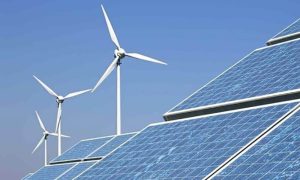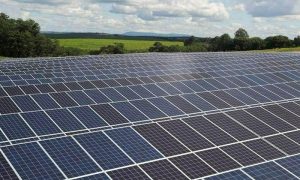Engr. Syed Sibte Ahmed Jafri, PE; FIE (Pak); FIEEE (Pak) ,
CEO, Jafri and Associates (Pvt) Ltd

Introduction
Energy is essential to all walks of life. And more specifically, electrical energy is a necessary component for the growth of a nation. It was estimated by the Energy Information Administration (US Department of Energy), that in 2006, 86% of primary energy production in the world came from burning fossil fuels (petroleum oil, coal, natural gas).’
While it may seem that this prime energy source is limitless, the reality is the complete opposite. A US publication, The Oil & Gas Journal, estimates the years of production left in the ground for oil, gas, and coal is 43, 167, and 417 years, respectively (Oil & Gas Journal: World Oil) The increased demand for fossil fuel coupled with the limited supply is the reason for rising costs for today s fuel. Developing countries, such as Pakistan, are unable to cope with the increased costs of petroleum and should therefore look into cheaper. Renewable energy alternatives.
Fossil Fuel also comes with inherently adverse environmental effects. The burning of fossil fuel produces excessive amounts of carbon dioxide; more than twice the amount that can be absorbed by nature. The excess carbon dioxide becomes a greenhouse gas, which leads to global warming. In the United States, more than 90% of greenhouse gas emissions come from the combustion of fossil fuels.2
Increased cost of fuel due to limited resources and negative environmental effects are the two main reasons why scientists are looking into Renewable Energy that is also “nature friendly”.
Ocean Based Power — An Answer
The ocean is vast. It covers 71% of the world’s surface (an area of some 361 million square kilometers) and has significant impact on the earth: the ocean water is the main source for rainwater, regulates the air temperature and wind patterns, is home to millions of diverse marine life, provides a means for transportation of the world’s goods, and of course, has an enormous electrical energy potential.
It has been estimated that if less than 0.1% of the renewable energy available within the oceans was converted into electricity, it would satisfy present world demand for energy more than five times over.3 The French Rance tidal power station alone peeks at 240 megawatts of power. 4 With the demand for alternative fuel rising, new renewable energy sources are being explored. Ocean based power seems to be an answer to the growing needs of the people. Some different types of Ocean Power sources are listed below
Wave Energy
Electrical Energy can be harnessed from the energy produced by waves on the ocean’s surface. Wave energy generation is still a research field and there are as many designs as companies active in this field.
One company in the US, Ocean Power Technologies Inc, has developed smart, floating buoys that drive a turbine upon its rise and fall and convert the ocean wave kinetic energy to electrical energy. Using OPT’s PowerBuoy wave generation system, a 10-Megawatt station would occupy only approximately 30 acres (0.125 square kilometers) of ocean space.5
An Australian company Carnegie Corporation Ltd (no relevance to the Carne9ie Foundation of New York) has developed the world’s first fully-submerged wave power converter unit, called CETO. The ocean’s waves causes high pressure seawater to be sent via pipes to shore. This high-pressured seawater is used to generate electricity or to produce zero-emission freshwater (utilizing standard reverse osmosis desalination technology). CETO, therefore, has no need for undersea grids or high voltage transmission nor costly marine qualified plants.6
Tidal Energy
Tidal stream devices extract energy from the diurnal flow of tidal currents caused by the gravitational pull of the moon. Electrical energy is harnessed from the rising and falling of tides. In one such system, Tide energy from high tides are trapped in a reservoir. When the tide drops, the water behind the reservoir flows through a power turbine, generating electricity. Unlike wind and wave power, tidal streams offer entirely predictable output.
An example of such an operational power plant is the Rance tidal power plant in France, which opened in November 1966 and is the world’s first electrical generating station powered by tidal energy. The Rance uses a 330 meter long dam, consisting of 24 bulb type turbine generators 5.35 meters in diameter, 470 tons in weight, and rated at 10MW each which generate electricity whether the tide is going in or out. Although the peak power capacity is 240MW, the average power generated is 68MW for an annual output of around 600 million kWh units of electricity.4
In November 1996, the Rance celebrated 30 years of active service during which time 16 billion kWh of electricity were generated without major incident or mechanical breakdown. In spite of the high cost of the project (620 million Francs – roughly 94.5 Million Euros), the plant’s costs have now been recovered, and electricity production costs are lower than for nuclear power generation (0.018 Euro per kWh, versus 0.025 Euro per kWh for nuclear). Today, the Rance also serves as a tourist attraction and attracts 200,000 visitors per year.7
As mentioned earlier, tidal streams & waves are predictable and are available by many marine information agencies throughout the year. Such information, although limited, can be found on the Pakistan Meteorological Department website.8
Ocean Thermal Energy Conversion (OTEC)
The oceans cover a little more than 70 percent of the Earth’s surface. This makes them the world’s largest solar energy collector and energy storage system. This stored energy is in the form of temperature differences between the upper and deeper parts of the ocean water.
The US National Renewable Energy estimates that on an average day, 60 million square kilometers (23 million square miles) of tropical seas absorb an amount of solar radiation equal in heat content to about 250 billion barrels of oil. If less than one-tenth of one percent of this stored solar energy could be converted into electric power, it would supply more than 20 times the total amount of electricity consumed in the United States on any given day. OTEC, or ocean thermal energy conversion, is an energy technology that converts solar radiation to electric power. OTEC systems use the ocean’s natural thermal gradient—the fact that the ocean’s layers of water have different temperatures—to drive a power-producing cycle. As long as the temperature between the warm surfaces water and the cold deep water differs by about 20°C (36°F).9
In May 1993, an open-cycle OTEC plant at Keahole Point, Hawaii, produced 50,000 watts of electricity during a net power-producing experiment. This broke the record of 40,000 watts set by a Japanese system in 1982. Today, scientists are developing new, cost-effective, state-of-the-art turbines for open-cycle OTEC systems.10
Other Ocean Related Energy Sources:
Osmotic Power
When a river runs into the ocean and the freshwater mixes with the saltwater, huge amounts of energy are unleashed. By placing a semi-permeable membrane (i.e. a membrane that retains the salt ions but allows water through) between reservoirs containing freshwater and seawater, respectively, a net flow of water towards the saltwater side will be observed.
Osmotic Power, or less commonly known as Salinity Gradient Power, is the energy retrieved from the flow of water from the freshwater side to the saltwater side. If the saltwater compartment has a fixed volume the pressure will increase towards a theoretical maximum of 26 bars. This pressure is equivalent to a column of water 270 meters high. It is estimated that each year 1600 TWh (terawatt-hours) could be generated worldwide.
The osmotic power plant is very area efficient. A 25 MW plant would only require some 40,000 m2 of land even if it is located above the ground. Wind farms or biomass harvest sites would require a relatively larger area of land to produce the same amount of energy.
Two practical methods for this are Reverse electro-dialysis (RED), and Pressure retarded osmosis (PRO). The PRO power plant is similar to a reverse osmosis desalination plant running backwards. A Norwegian company, Statkraft, has announced that it will build a PRO plant prototype in Hurum in Buskerud. Construction of the prototype started in 2008, and was planned to produce 2 to 4 kilowatts.11
Marine Algae Biofuel
Marine algae offer a vast renewable energy source for countries around the world that have a suitable coastline available. Utilising marine as opposed to terrestrial biomass for energy production circumvents the problem of switching agricultural land from food to fuel production. In addition, the production of marine biomass will not be limited by freshwater supplies, another of the contentious issues of increasing terrestrial biofuel production.
Algae have the capability to grow rapidly in sunlight and can have a high percentage of lipids or oils depending on the species. It can double its mass several times a day and produce at least 15 times more oil per acre than alternatives such as rapeseed, palms, soybeans, corn or jatropha. Algae with a good lipid factor (vegoil in relation to algae cells) can be made into vegetable oil, bio-diesel, bio-ethanol, bio-gasoline, bio-methanol, bio- butane and other bio-fuels.12
devious studies have shown that marine algae are as good a feedstock for anaerobic digestion (AD) processes as terrestrial sources Marine algae contain no lignin and little cellulose; demonstrate high conversion efficiencies, rapid conversion rates and good process stability. And to top if off, the by-product residue is suitable for use as nutrient supplements for agriculture. 1 *
Conclusion
Ocean based power provides a cheaper and emission-free alternative to fossil fuel. Further research has yet to me made in this field, as many government agencies are calling for such assistance by the science and engineering community.14 To date there are no such ocean-based power plants built in Pakistan.
The Pakistani Model
The above describes a plethora of the various options. Each of the above potentials can be harnessed in Pakistan given the opportunity. So far as is known little work has been done on any of the above options in Pakistan and therefore no data are available.
However, some data is available for the tidal flow potential. The Pakistan Meteorological Department has a total of 8 stations collecting hourly data of the tidal flow around the clock, throughout the year. The tables that follow are collected from the data obtained by those sensing stations. Accordingly the potential power that can be generated and the financial viability, therefore, is presented for further study and application.








